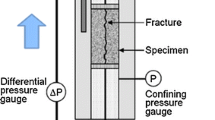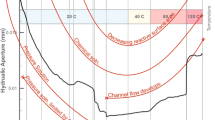Abstract
The geological formation immediately surrounding a nuclear waste disposal facility has the potential to undergo a complex set of physical and chemical processes starting from construction and continuing many years after closure. The DECOVALEX project (DEvelopment of COupled models and their VALidation against EXperiments) was established and maintained by a variety of waste management organisations, regulators and research organisations to help improve capabilities in experimental interpretation, numerical modelling and blind prediction of complex coupled systems. In the present round of DECOVALEX (D-2015), one component of Task C1 has considered the detailed experimental work of Yasuhara et al. (Earth Planet Sci Lett 244:186–200, 2006), wherein a single artificial fracture in novaculite (micro- or crypto-crystalline quartz) is subject to variable fluid flows, mechanical confining pressure and different applied temperatures. This paper presents a synthesis of the completed work of six separate research teams. A range of approaches are presented including 2D and 3D high-resolution coupled thermo–hydro–mechanical–chemical models. The results of the work show that while good, physically plausible representations of the experiment can be obtained using a range of approaches, there is considerable uncertainty in the relative importance of the various processes, and that the parameterisation of these processes can be closely linked to the interpretation of the fracture surface topography at different spatial scales.

























Similar content being viewed by others
References
Alexander GB, Heston WM, Iler RK (1954) The solubility of amorphous silica in water. J Phys Chem 58:453
Atkinson BK (1987) Fracture mechanics of rock. Academic Press, London
Berkowitz B (2002) Characterizing flow and transport in fractured geological media: a review. Adv Water Resour 25(8):861–884
Bethke CM, Yeakel S (2013) Reactive transport modeling guide. Aqueous Solutions, LLC, Champaign. http://gwb.com/pdf/GWB9/GWBtransport.pdf
Bond A (2016) Task C1 Final Report. KTH Report ISBN 978-91-7595-829-3(06), ISSN 1650-86-10
Bond AE, Benbow S, Wilson J, McDermott C, English M (2012) Coupled hydro–mechanical–chemical process modelling argillaceous formations for DECOVALEX-2011. Mineral Mag 76(8):3131–3143
Bond A, Thatcher K, Chittenden N, McDermott C, Fraser-Harris A (2015a) RWM Coupled Processes Project: First Annual Report for RWM participation in DECOVALEX-2015 Tasks A and C1. AMEC report 18040-TR-002 v2.0. RWM Peer Reviewed Technical Report. https://rwm.nda.gov.uk/publication/rwm-coupled-processes-project-first-annual-report-for-rwm-participation-in-decovalex-2015-tasks-a-and-c1/
Bond A, Thatcher K, Chittenden N, McDermott C, Fraser-Harris A (2015b) RWM Coupled Processes Project: Second Annual Report for RWM participation in DECOVALEX-2015 Tasks A and C1. AMEC report 18040-TR-003 v3.0. RWM Peer Reviewed Technical Report. https://rwm.nda.gov.uk/publication/rwm-coupled-processes-project-second-annual-report-for-rwm-participation-in-decovalex-2015-tasks-a-and-c1/
Bond AE, Brusky I, Cao T, Chittenden N, Fedors R, Feng X-T, Gwo J-P, Lang P, McDermott C, Neretnieks I, Pan PZ, Šembera J, Watanabe N, Zheng H (2016) Development of approaches for modelling coupled thermal–hydraulic–mechanical–chemical processes in single granite fracture experiments. http://www.decovalex.org/resources.html#special-issues
Brown SR, Scholz CH (1985) Closure of random elastic surfaces in contact. J Geophys Res 90(B7):5531
Cao T (2015) Mass balance equations for a single fracture, DECOVALEX-2015 Task C1. Intra-office Note to J. Rubenstone October 28, 2015, U.S. Nuclear Regulatory Commission. ADAMS ML15301A815. http://www.nrc.gov/reading-rm/adams.html
Chittenden N, McDermott CI, Bond AE, Wilson J, Norris S (2016) Evaluating the importance of different coupled thermal, hydraulic, mechanical and chemical process simulations during fluid flow experiments in fractured novaculite and fractured granite. http://www.decovalex.org/resources.html#special-issues
Dove PM (1995) Geochemical controls on the kinetics of quartz fracture at subcritical tensile stresses. J Geophys Research: Solid Earth 100(B11):22349–22359
Dove PM, Crerar DA (1990) Kinetics of quartz dissolution in electrolyte solutions using a hydrothermal mixed flow reactor. Geochim Cosmochim Acta 54:955–969
Eyring H (1935) The activated complex in chemical reactions. J Chem Phys 3(2):107–115
Feng XT, Pan PZ, Zhou H (2006) Simulation of the rock microfracturing process under uniaxial compression using an elasto-plastic cellular automaton. Int J Rock Mech Min Sci 43(7):1091–1108
Fetter CW (1994) Applied hydrogeology, 3rd edn. Prentice Hall, Englewood Cliffs
Gunnarson I, Arnórsson S (2000) Amorphous silica solubility and the thermo dynamic properties of H4SiO4 in the range of 0° to 350 °C at Psat. Geochim Cosmochim Acta 64:2295–2307
Gwo JP, D’Azevedo EF, Frenzel H, Mayes M, Yeh G-T, Jardine PM, Salvage KM, Hoffman FM (2001) HBGC123D: a high-performance computer model of coupled hydrogeological and biogeochemical processes. Comput Geosci 27:1231–1242
Gwo J, Cao T, Fedors R, Rubenstone J (2015) Modeling the coupled hydrogeochemical and mechanical behavior of a single artificial fracture in novaculite rock. In: Proceedings paper for the international high-level radioactive waste management conference. American Nuclear Society, La Grange Park
Johnson JW, Oeklers EH, Helgeson H (1992) SUPCRT92: a software package for calculating the standard molal thermodynamic properties of minerals, gases, aqueous species, and reactions for 1–5000 bar and 0–1000 °C. Comput Geosci 18:899–947
Kolditz O, Bauer S, Bilke L, Böttcher N, Delfs JO, Fischer T, Görke UJ, Kalbacher T, Kosakowski G, McDermott CI, Park CH, Radu F, Rink K, Shao H, Shao HB, Sun F, Sun YY, Singh AK, Taron J, Walther M, Wang W, Watanabe N, Wu N, Xie M, Xu W, Zehner B (2012) OpenGeoSys: an open-source initiative for numerical simulation of thermo–hydro–mechanical/chemical (THM/C) processes in porous media. Environ Earth Sci 67(2):589–599
Lang PS, Paluszny A, Zimmerman RW (2015) Hydraulic sealing due to pressure solution contact zone growth in siliciclastic rock fractures. J Geophys Res Solid Earth 120(6):4080–4101. doi:10.1002/2015JB011968
Matthäi SK, Mezentsev AA, Pain CC, Eaton MD (2005) A high-order TVD transport method for hybrid meshes on complex geometry. Int J Numer Methods Fluids 47:1181–1187
McCraw C, Edlmann K, Miocic J, Gilfillan S, Haszeldine S, McDermott C (2016) Experimental investigation and hybrid numerical analytical hydraulic mechanical simulation of supercritical CO2 flowing through a natural fracture in caprock. Int J Greenhouse Gas Control 48:120–133. http://dx.doi.org/10.1016/j.ijggc.2016.01.002
McDermott C, Bond A, Fraser-Harris A, Chittenden N, Thatcher K (2015) Application of hybrid numerical and analytical solutions for the simulation of coupled thermal hydraulic mechanical and chemical processes during fluid flow through a fractured rock. http://www.decovalex.org/resources.html#special-issues
Neretnieks I (2014) Stress-mediated closing of fractures—impact of matrix diffusion. J Geophys Res Solid Earth 119(5):4149–4163
Neuman SP (2005) Trends, prospects and challenges in quantifying flow and transport through fractured rocks. Hydrogeol J 13(1):124–147
Palandri JL, Kharaka YK (2004) A compilation of rate parameters of mineral-water interaction kinetics for application to geochemical modelling. US Geological Survey Open File Report 2004-1068. https://pubs.usgs.gov/of/2004/1068/pdf/OFR_2004_1068.pdf
Paluszny A, Matthäi SK, Hohmeyer M (2007) Hybrid finite element-finite volume discretization of complex geologic structures and a new simulation workflow demonstrated on fractured rocks. Geofluids 7(2):186–208
Pan PZ, Feng XT (2013) Numerical study on coupled thermo-mechanical processes in Äspö Pillar Stability Experiment. J Rock Mech Geotech Eng 5(2):136–144
Pan PZ, Feng XT, Huang XH, Cui Q, Zhou H (2009) Coupled THM processes in EDZ of crystalline rocks using an elasto-plastic cellular automaton. Environ Geol 57(6):1299–1311
Pan P-Z, Feng X-T, Xu D-P, Shen L-F, Yang J-B (2011) Modelling fluid flow through a single fracture with different contacts using cellular automata. Comput Geotech 38(8):959–969
Pan P-Z, Feng X-T, Zheng H, Bond A (2016) An approach to simulate the THMC process in single novaculite fracture using EPCA. http://www.decovalex.org/resources.html#special-issues
Polak A, Elsworth D, Yasuhara H, Grader AS, Halleck PM (2003) Permeability reduction of a natural fracture under net dissolution by hydrothermal fluids. Geophys Research Lett 30(20):2020
Poon CY, Sayles RS, Jones TA (1992) Surface measurement and fractal characterization of naturally fractured rocks. J Phys D 25:1269
Quintessa (2013) QPAC: Quintessa’s General-Purpose Modelling Software. QRS-QPAC-11. www.quintessa.org/qpac
Rimstidt JD (1997) Quartz solubility at low temperatures. Geochim Cosmochim Acta 61:2553–2558
Schmittbuhl J, Schmitt F, Scholz C (1995) Scaling invariance of crack surfaces. J Geophys Res 100:5953–5973
Taron J, Elsworth D, Min KB (2009) Numerical simulation of thermal–hydrologic–mechanical–chemical processes in deformable, fractured porous media. Int J Rock Mech Min Sci 46(5):842–854
Tester JW, Worley WG, Robinson BA, Grigsby CO, Feerer JL (1994) Correlating quartz dissolution kinetics in pure water from 25 to 625 °C. Geochim Cosmochim Acta 58:2407–2420
Walsh J (1981) Effect of pore pressure and confining pressure on fracture permeability. Int J Rock Mech Min Sci Geomech 18(5):429–435
Watson C, Wilson J, Savage D, Benbow S, Norris S (2016) Modelling reactions between alkaline fluids and fractured rock: the Maqarin natural analogue. Appl Clay Sci 121–122:46–56
Yasuhara H, Elsworth D (2006) A numerical model simulating reactive transport and evolution of fracture permeability. Int J Numer Anal Methods Geomech 30(10):1039–1062
Yasuhara H, Elsworth D (2008) Compaction of a rock fracture moderated by competing roles of stress corrosion and pressure solution. Pure Appl Geophys 165:1289–1306
Yasuhara H, Elsworth D, Polak A (2004) Evolution of permeability in a natural fracture: significant role of pressure solution. J Geophys Res 109:B03204
Yasuhara H, Polak A, Mitani Y, Grader A, Halleck P, Elsworth D (2006) Evolution of fracture permeability through fluid–rock reaction under hydrothermal conditions. Earth Planet Sci Lett 244:186–200
Yasuhara H, Kinoshita N, Ohfuji H, Lee DS, Nakashima S, Kishida K (2011) Temporal alteration of fracture permeability in granite under hydrothermal conditions and its interpretation by coupled chemo-mechanical model. Appl Geochem 26:2074–2088
Zhang Y-J, Yan C-S, Xu G (2012) FEM analyses for T-H-M-M coupling processes in dual-porosity rock mass under stress corrosion and pressure solution. J Appl Math, Article ID 983718, 21 pages. doi:10.1155/2012/983718
Zimmerman RW, Kumar S, Bodvarsson GS (1991) Lubrication theory analysis of the permeability of rough-walled fractures. Int J Rock Mech Min Sci 28(4):325–331
Acknowledgements
The authors appreciate and thank the funding organisations for their financial and technical support of the DECOVALEX project work described in this paper. In part, this work was financially supported by National Natural Science Foundation of China (Nos. 51322906, 41272349). The statements made in the paper are, however, solely those of the authors and do not necessarily reflect those of the funding organisation(s).
Author information
Authors and Affiliations
Corresponding authors
Additional information
Disclaimer The views expressed herein do not necessarily reflect the views or regulatory positions of the US Nuclear Regulatory Commission (USNRC) and do not constitute a final judgment or determination of the matters addressed or of the acceptability of any licensing action that may be under consideration at the USNRC. Also, no responsibility is assumed by the authors for any damage to property or persons as a result of operation or use of this publication and/or the information contained herein.
This article is part of a Topical Collection in Environmental Earth Sciences on ‘DECOVALEX 2015’, guest-edited by Jens T. Birkholzer, Alexander E. Bond, John A. Hudson, Lanru Jing, Hua Shao and Olaf Kolditz.
Appendix: Codes and modelling approaches
Appendix: Codes and modelling approaches
See Table 3.
Rights and permissions
About this article
Cite this article
Bond, A.E., Bruský, I., Cao, T. et al. A synthesis of approaches for modelling coupled thermal–hydraulic–mechanical–chemical processes in a single novaculite fracture experiment. Environ Earth Sci 76, 12 (2017). https://doi.org/10.1007/s12665-016-6326-6
Received:
Accepted:
Published:
DOI: https://doi.org/10.1007/s12665-016-6326-6




